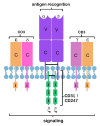Epithelial Ovarian Cancer and the Immune System: Biology, Interactions, Challenges and Potential Advances for Immunotherapy
- PMID: 32937961
- PMCID: PMC7564553
- DOI: 10.3390/jcm9092967
Epithelial Ovarian Cancer and the Immune System: Biology, Interactions, Challenges and Potential Advances for Immunotherapy
Abstract
Recent advances in the understanding of immune function and the interactions with tumour cells have led to the development of various cancer immunotherapies and strategies for specific cancer types. However, despite some stunning successes with some malignancies such as melanomas and lung cancer, most patients receive little or no benefit from immunotherapy, which has been attributed to the tumour microenvironment and immune evasion. Although the US Food and Drug Administration have approved immunotherapies for some cancers, to date, only the anti-angiogenic antibody bevacizumab is approved for the treatment of epithelial ovarian cancer. Immunotherapeutic strategies for ovarian cancer are still under development and being tested in numerous clinical trials. A detailed understanding of the interactions between cancer and the immune system is vital for optimisation of immunotherapies either alone or when combined with chemotherapy and other therapies. This article, in two main parts, provides an overview of: (1) components of the normal immune system and current knowledge regarding tumour immunology, biology and their interactions; (2) strategies, and targets, together with challenges and potential innovative approaches for cancer immunotherapy, with attention given to epithelial ovarian cancer.
Keywords: MUC16; adoptive T-cell therapy; checkpoint inhibition; glycans; immune system; immunotherapy; ovarian cancer; tumour microenvironment.
Conflict of interest statement
The authors declare no conflict of interest.
Figures



Similar articles
-
Future perspectives in melanoma research : Meeting report from the "Melanoma Bridge". Napoli, December 1st-4th 2015.J Transl Med. 2016 Nov 15;14(1):313. doi: 10.1186/s12967-016-1070-y. J Transl Med. 2016. PMID: 27846884 Free PMC article.
-
Immune checkpoint inhibitors in ovarian cancer: where do we go from here?Cancer Drug Resist. 2023 Jun 14;6(2):358-377. doi: 10.20517/cdr.2023.13. eCollection 2023. Cancer Drug Resist. 2023. PMID: 37457131 Free PMC article. Review.
-
New Approaches for Immune Directed Treatment for Ovarian Cancer.Curr Treat Options Oncol. 2016 Mar;17(3):14. doi: 10.1007/s11864-016-0389-1. Curr Treat Options Oncol. 2016. PMID: 26942589 Review.
-
The immune landscape of neuroblastoma: Challenges and opportunities for novel therapeutic strategies in pediatric oncology.Eur J Cancer. 2021 Feb;144:123-150. doi: 10.1016/j.ejca.2020.11.014. Epub 2020 Dec 18. Eur J Cancer. 2021. PMID: 33341446 Review.
-
Efficacy evaluation of multi-immunotherapy in ovarian cancer: From bench to bed.Front Immunol. 2022 Oct 6;13:1034903. doi: 10.3389/fimmu.2022.1034903. eCollection 2022. Front Immunol. 2022. PMID: 36275669 Free PMC article. Review.
Cited by
-
Comprehensive Landscape of Ovarian Cancer Immune Microenvironment Based on Integrated Multi-Omics Analysis.Front Oncol. 2021 Jun 17;11:685065. doi: 10.3389/fonc.2021.685065. eCollection 2021. Front Oncol. 2021. PMID: 34222009 Free PMC article.
-
Comprehensive bioinformatics analysis of co-mutation of FLG2 and TP53 reveals prognostic effect and influences on the immune infiltration in ovarian serous cystadenocarcinoma.Transl Cancer Res. 2025 Feb 28;14(2):1282-1296. doi: 10.21037/tcr-24-1596. Epub 2025 Feb 17. Transl Cancer Res. 2025. PMID: 40104745 Free PMC article.
-
Quantum Dots in Cancer Theranostics: A Thorough Review of Recent Advancements in Bioimaging, Tracking, and Therapy Across Various Cancer Types.Curr Pharm Biotechnol. 2025;26(8):1120-1142. doi: 10.2174/0113892010294163240407153842. Curr Pharm Biotechnol. 2025. PMID: 38644717 Review.
-
Lifetime Exposure to Cigarette Smoke and Risk of Ovarian Cancer by T-cell Tumor Immune Infiltration.Cancer Epidemiol Biomarkers Prev. 2023 Jan 9;32(1):66-73. doi: 10.1158/1055-9965.EPI-22-0877. Cancer Epidemiol Biomarkers Prev. 2023. PMID: 36318652 Free PMC article.
-
Identification of Hypoxia Signature to Assess the Tumor Immune Microenvironment and Predict Prognosis in Patients with Ovarian Cancer.Int J Endocrinol. 2021 Dec 14;2021:4156187. doi: 10.1155/2021/4156187. eCollection 2021. Int J Endocrinol. 2021. PMID: 34950205 Free PMC article.
References
-
- Zhang L., Conejo-Garcia J.R., Katsaros D., Gimotty P.A., Massobrio M., Regnani G., Makrigiannakis A., Gray H., Schlienger K., Liebman M.N., et al. Intratumoral T cells, recurrence, and survival in epithelial ovarian cancer. N. Engl. J. Med. 2003;348:203–213. doi: 10.1056/NEJMoa020177. - DOI - PubMed
Publication types
Grants and funding
LinkOut - more resources
Full Text Sources
Research Materials
Miscellaneous

